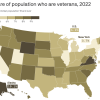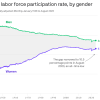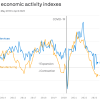When it comes to Millennials and retail, two opposing story lines compete, experts say. In the first, these younger shoppers star as the industry’s most important drivers of growth — the saviors of the mall. In the second, skeptics question how Millennials can be so important when it is their parents who have the real money.
So where does the truth lie? According to both government and private -research, Millennials do indeed have lower household incomes than both Gen-Xers and baby boomers. A Pew Research Center analysis of census data shows median household income for Millennials in 2013 to have been $61,003. By comparison, Gen-Xers earned $73,200, the research says, while boomers earned $65,843.
A 2014 survey of 1,800 shoppers in major markets similarly disclosed that Millennials make less money than their elders, according to David D. Lobaugh, president of Marietta, Ga.–based August Partners, which conducted the research for ICSC. “In our survey sample, the average household income for Millennials was $69,702,” Lobaugh said. “The average household income for respondents in the ‘non-Millennials’ bucket was substantially higher, at $89,768.”
Confronted with this disparity, some in the shopping center industry might be tempted to conclude that Millennials (generally defined as 18- to 34-year-olds) are not worth targeting. “However, there’s a significant difference between demographic data such as household income and what you learn from more-nuanced consumer research,” Lobaugh said. “Consumer research is actionable and can help you optimize the tenant mix at a property. It consistently shows that Millennials spend more on apparel, shoes and accessories. And by the way, they spend more on dining out, too.”
In the August Partners survey for ICSC, Millennial respondents reported spending an average of $1,024 each on apparel annually, while non-Millennials spent an average of $904 each. Perhaps more tellingly, the firm’s research shows that Millennials are more likely to fall into the so-called fashion-forwards category — shoppers who regard being in style as a top priority in their lives. “Average household income is important, but I will tell you what can trump -income every time: a metric we call ‘fashion stance,’” said Lobaugh. “In market after market, ‘fashion-forwards’ spend 70 to 75 percent more on apparel than their non-forwards counterparts. It’s ‘mindset over matter.’”
If household income alone were predictive of spending habits, then Millennials would buy food at discount stores and steer clear of the likes of Whole Foods Market, points out Jeff Green, who heads an eponymous retail consulting firm in Phoenix. Instead, these younger shoppers tend to spend freely on what they perceive to be healthier and higher-quality food and drink, he says. “I travel all the time and will often go to Whole Foods to eat,” Green said. “I’ll sit and watch people coming and going. Invariably, it is the young people who are buying $10 juices. I laugh, because when I was in college, all I ate was hot dogs and Ramen noodles.”
Catering to Millennials is reportedly part of the strategy behind a Whole Foods’ spin-off concept called 365 by Whole Foods Market. In July Whole Foods announced plans to open the first of these smaller-format stores — in Bellevue, Wash.; Houston; Portland, Ore.; Santa Monica, Calif.; and the Silver Lake neighborhood of Los Angeles. Some analysts see this as an attempt to go head-to-head with Trader Joe’s by offering a Millennials-friendly mix of higher-quality food, trendier stores and lower prices. The initial store openings are slated for the second half of 2016, with as many as 10 additional openings in 2017, the company says.
As Green sees it, focusing on the differences between the incomes of Millennials and their parents ignores an important truth: that these younger shoppers often get plenty of money from their elders. “Even if the parents do have more money, does it really matter?” Green said. “Either way, [the Millennials] are spending.”
Members of prior generations typically struck out on their own at about age 18, but some Millennials appear to rely on their families until much later in life, says Liz Gillespie, vice president of marketing at North American Properties. “People who are in their 20s right now are definitely aware of brands and will still pay more for a certain purse or sunglasses or shoes,” she said. “Often the parents are there to help them maintain the discerning lifestyles they have created for themselves.”
Still, rather than going after Millennials per se, North American Properties, for one, strives to take a different tack as it plans and leases new projects, according to Gillespie. At its two major mixed-use projects in metro Atlanta — Atlantic Station and Avalon — the firm seeks to appeal to what Gillespie calls a “new-class consumer.” These shoppers are technology-driven, forward-thinking and socially connected, and regardless of age, they enjoy urban environments and dislike long commutes, she says. “Rather than targeting age groups, we target a mind-set,” Gillespie said. “Millennials may want to be in places that are entertaining, walkable and connected, with lots of shops, bars and restaurants, but their parents want the same things.”
The notion of Millennials as all-important is understandable, but incomplete, says Yaromir Steiner, CEO of Steiner & Associates, a Columbus, Ohio–based developer of mixed-use properties. “Millennials make for a good story, but ultimately, society is changing as a whole,” Steiner said. “Many of the things Millennials are spearheading are just as important to everybody else.” Steiner cites the way he and his wife started texting Google Maps to each other, a technique they learned from their son. “He sent us the text, and when we clicked on the map, my wife’s Apple Watch started giving us directions,” Steiner said. “We copied his behavior. We are not Millennials, but we are learning from them.”
What appeals to Millennials, in other words, increasingly feels relevant to older generations as well. While some media reports have portrayed Steiner’s Liberty Center — a $350 million, mixed-use project slated to open this fall in Cincinnati’s northern suburbs — as being designed with Millennials in mind, its appeal will in fact be multigenerational, Steiner says. Tenants such as The Cheesecake Factory will certainly appeal to Gen-Xers and baby boomers, the developer notes. But just as Millennials-friendly Chipotle Mexican Grill is famous for being transparent about its sourcing, even Cheesecake Factory is now touting its animal-welfare policy and commitment to sustainable produce, Steiner says. The developer sees in this a sign of broader societal shifts, and he suggests that generational lines are blurring in other ways as well. “Today Celtic-themed bars that emphasize soccer are important,” Steiner said. “But after 25 years of introducing soccer to America, now the World Cup championship game has more viewers than any other. Is that a Millennials phenomenon? I see it as a societal phenomenon.”
Tenants come and go, but one way to guarantee the lasting appeal of a project is to make sure its public spaces satisfy universal needs that are not specific to any particular generation, Steiner says. This is precisely why developers have over the years honed their focus on creating exciting environments with lively public spaces, he says. For its part, Liberty Center will include unusual amenities such as a one-acre, meditative rooftop garden, a spacious community house for gatherings, and even a multidenominational chapel for yoga classes, religious services and the like. “When you create a project that is going to last 50 years, you have to worry about a bit more than just the Millennials,” Steiner said.
In any case, Millennials already play an outsized role in retail development, Green says. They are keen on snapping up fast fashions at the likes of H&M, Uniqlo and Zara, which is part of the reason today’s landlords pay such close attention to them. These younger shoppers will also be important to the new wave of retailers — BaubleBar, Birchbox, Bonobos, Pirch and Warby Parker among them — that are now moving from the Internet to brick-and-mortar stores, he says. And of course, Millennials will continue to be important to mixed-use developments as both shoppers and residents, Green predicts.
Even those who question the current spending power of Millennials say it makes sense to target them now in a bid to win their long-term loyalty. “I tend to think Millennials are overrated — for now,” said Rachel Elias Wein, president of real estate consulting firm WeinPlus. “I’m at the very tail end of Gen-X — mid-30s, married with three kids. This is the demographic that does the buying.” Indeed, Wein says, Millennials’ willingness to put off buying homes, getting married and having children until later in life is part of what defines their generation. “It’s going to take some time, years or even a decade, before they have the buying power needed to shape retail,” she said. “However, retailers and shopping centers can grab them now in their early years. The hope is that brand loyalty will make these buyers stick with them once the heavy spending begins.” SCT









